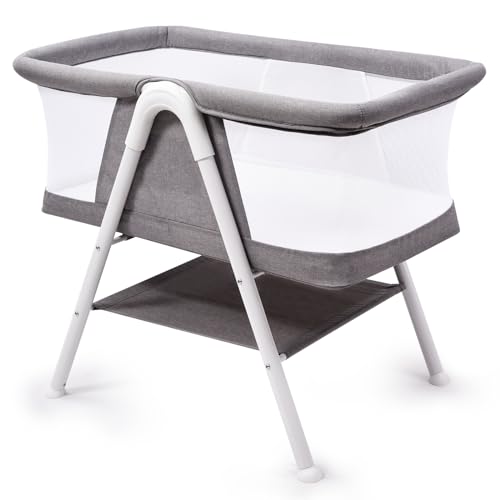10 Healthy Baby Co Sleeper Crib Habits

Understanding Baby Co-Sleeper Cribs: A Comprehensive Guide
As new parents get ready for the arrival of their kids, the argument over sleeping arrangements often emerges. The option in between different cribs, bed-sharing, and co-sleeping is a significant factor to consider. In the last few years, co-sleeper cribs have actually gotten significant popularity due to their viewed benefits for both parents and infants. This short article will explore what baby co-sleeper cribs are, their benefits and drawbacks, how they compare to standard cribs, and vital safety standards.
What is a Baby Co-Sleeper Crib?
A baby co-sleeper crib, also understood as a bedside crib or sidecar crib, is developed to be positioned next to the moms and dad's bed. It permits parents to have their baby close by throughout sleep without the risks associated with bed-sharing. click through the next document designed cribs often include adjustable height settings, safety straps, and a removable side panel, making them a convenient option for nighttime feeding and comforting.
Key Features of Co-Sleeper Cribs:
- Height Adjustability: Enables the crib to line up completely with the parents' mattress.
- Detachable Side Panel: Facilitates easy access to the baby for feeding or calming.
- Security Straps: Secure the crib to the moms and dad's bed to prevent any gaps.
- Compact Design: Saves space while providing convenience.
Benefits of Co-Sleeper Cribs
Co-sleeper cribs use various advantages for both parents and babies.
- Convenience of Nighttime Feeding: The close proximity permits parents to more quickly breastfeed or bottle-feed throughout the night.
- Promotes Bonding: Parents can more quickly comfort their babies, creating a strong psychological bond.
- Improved Sleep: Many parents find that having the baby close at hand lowers nighttime stress and anxiety, leading to better sleep for everyone.
- Simpler Monitoring: Parents can keep a close eye on their baby while sleeping, guaranteeing they are safe and comfortable.
- Much safer Alternative: Co-sleeper cribs reduce the threats related to bed-sharing, such as suffocation occurrences.
Table 1: Advantages of Co-Sleeper Cribs
| Benefit | Description |
|---|---|
| Convenience of Nighttime Feeding | Relieve of access for breastfeeding or soothing babies at night. |
| Promotes Bonding | Improved emotional connection through distance throughout sleep. |
| Improved Sleep | Minimized adult stress and anxiety causes a more relaxing night. |
| Much easier Monitoring | Localized view enhances reassurance for parents. |
| More secure Alternative | Lower threat of suffocation compared to bed-sharing. |
Disadvantages of Co-Sleeper Cribs
While co-sleeper cribs feature numerous advantages, they also have some disadvantages.
- Limited Use: Co-sleeper cribs are typically just utilized for the very first 6 months approximately, up until the baby starts to move around.
- Cost: Quality co-sleeper cribs can be more pricey than standard cribs.
- Space Constraints: A co-sleeper crib requires sufficient space beside the adult bed, which may not be available in smaller rooms.
- Feasibility for Larger Adults: Some adults may discover it unpleasant to lean over the crib for nighttime requirements.
Table 2: Disadvantages of Co-Sleeper Cribs
| Disadvantage | Description |
|---|---|
| Limited Use | Functional just for a short time up until the baby grows. |
| Cost | Higher rate point compared to conventional choices. |
| Space Constraints | Needs adequate space nearby to the adult bed. |
| Expediency for Larger Adults | May cause pain when reaching over for nighttime care. |
Comparing Co-Sleeper Cribs to Traditional Cribs
The option between co-sleeper cribs and conventional cribs greatly impacts the parenting experience.
Secret Differences:
| Feature | Co-Sleeper Crib | Standard Crib |
|---|---|---|
| Distance | Next to parent's bed | Separate room |
| Ease of access | Easy reach for nighttime care | Requires rising |
| Period of Use | 0-6 months, depending upon development | Typically used for several years |
| Size | Compact and space-saving | Generally bigger and more steady |
Security Guidelines for Co-Sleeper Cribs
To guarantee the best sleeping plan, parents should stick to specific safety standards when utilizing a co-sleeper crib:
- Secure the Crib: Use security straps or fastening systems to protect the co-sleeper to the adult bed, reducing space between the 2.
- Use a Firm Mattress: Make sure the bed mattress is firm and fits comfortably within the crib.
- Avoid Soft Bedding: Minimize the use of soft items such as pillows, blankets, or packed toys in the crib.
- Display Baby's Movement: Stay attentive to how the baby moves during sleep.
FAQs about Baby Co-Sleeper Cribs
Q1: Are co-sleeper cribs safe?
A1: Yes, when utilized according to safety standards, co-sleeper cribs can provide a safe sleep environment while keeping the baby near the parents.
Q2: How long can I use a co-sleeper crib?
A2: Co-sleeper cribs are normally designed for use from birth up until the baby is around 6 months old or can push themselves up.
Q3: Can I use a co-sleeper crib if I have a small bedroom?
A3: Yes, most co-sleeper cribs have a compact design, making them ideal for small spaces.
Q4: Do co-sleeper cribs require assembly?
A4: Most co-sleeper cribs require some assembly, but the procedure is generally straightforward and accompanied by directions.
Q5: What should I do if my baby grows out of the co-sleeper?
A5: Transition your baby to a standard crib in their own room or a close-by location that abides by safe sleep guidelines.
Baby co-sleeper cribs provide a compelling option for parents who wish to keep their infants nearby during sleep. They use many advantages, including ease of nighttime feeding and fostering close bonds. However, like all parenting choices, it's necessary to weigh the advantages and downsides and consider specific living scenarios and preferences. By adhering to safety guidelines, parents can create a safe and secure sleep environment for their kids, making sure comfort for the entire family.

